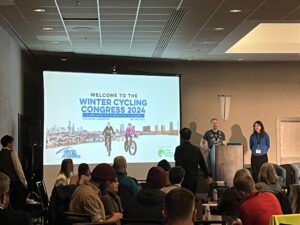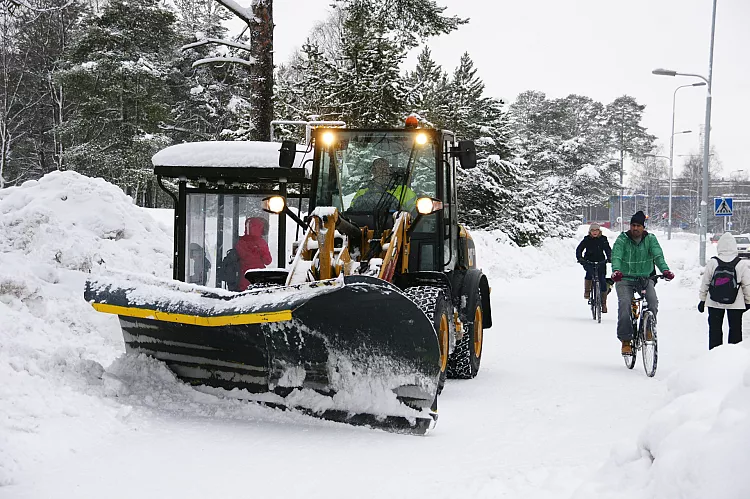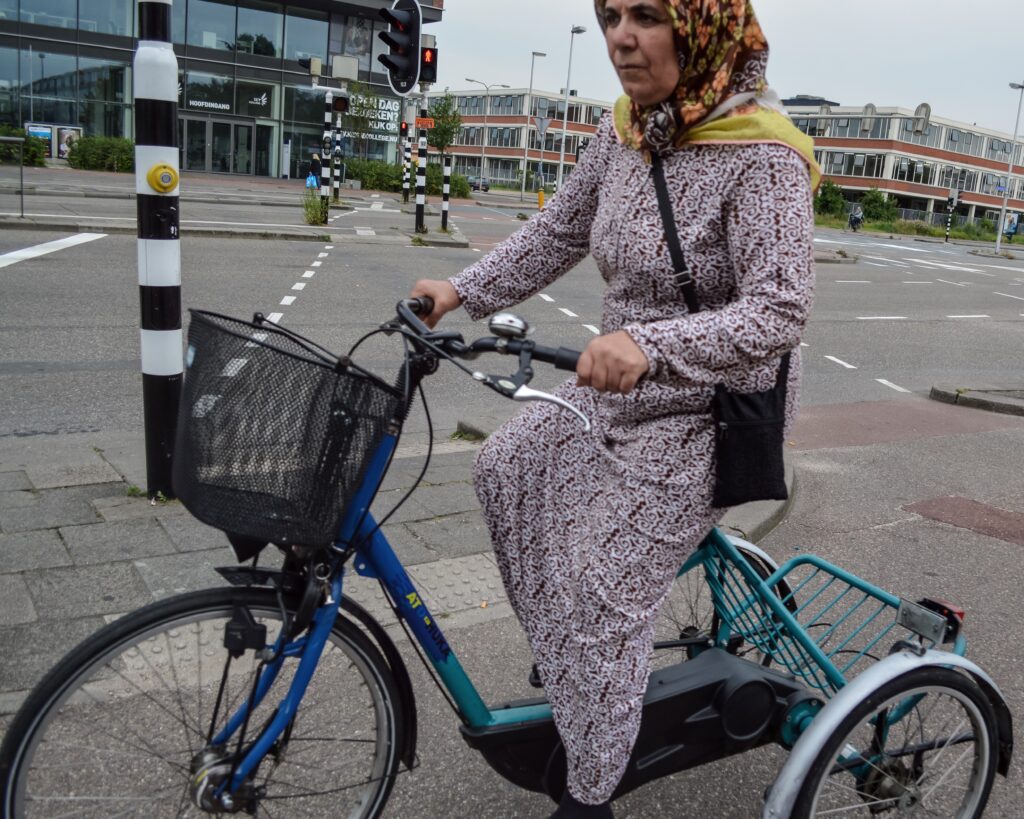Conference / Cycling / Winter Cycling
The 2024 Winter Cycling Congress: Talking Maintenance, Accessibility, and Safety
In late February this year I attended the 2024 Winter Cycling Congress. As a member of the board of the Winter Cycling Federation, I had the privilege of supporting the organization and planning the conference along with the local hosts. The goal of the conference is to bring together anyone and everyone interested in all-season cycling, including city staff, advocates, and consultants from around the world. This year it was held in Edmonton, Alberta, Canada.
With two full days of workshops, speakers, and activities, and having attended about a dozen different workshops and talks, there was plenty to learn and share with the over 200 conference participants. With this blog, I hope to boil down some of my main takeaways from the conference.

Winter Maintenance
There are countless technical intricacies of winter maintenance that I could totally nerd-out on, such as the pros and cons of at-grade cycle paths, drainage, or designing for snow storage. Perhaps a more ambiguous, less commonly discussed topic is that of contracting.
This stood out to me in a presentation by Harri Verala, a traffic engineer with the City of Oulu. Oulu is without a doubt the winter cycling capital of the world (more on that in my colleague, Eric’s blog). Harri was adamant on the importance of the relationship between the contractor, the city, and the public. He argues that this interdependent relationship should be evident in the contract, requiring winter maintenance to be understood as providing a public health service, rather than a simple matter of snow clearance. That a well-maintained cycle network is not just necessary for year-round use, but that it also contributes to the health and well-being of its users. For example, winter maintenance contractors in Oulu are required to organize occasional “roadside events”, such as delivering hot chocolate to cyclists, and collect feedback from users. Plough drivers are also required to regularly cycle various routes in the network so that they can feel for themselves the difference proper winter maintenance makes. Requiring them to cycle routes outside of their own plough route, also acts as an additional layer of quality control, monitoring other drivers’ work.

Of course, the contract should also ascribe technical requirements for quality control. Oulu sets ambitious time and snowfall limits within which the contractor must clear the network: Snow clearing operations should be ongoing at 2 centimeters (¾ inch); snow accumulation on the network may not exceed 4 centimeters (1 ½ inches) at any time; and their entire 165 km (102 mi) Class Super network should be cleared within 3 hours. Contractors will not go above and beyond the requirements set for them and will cut corners where possible, so any ambitious requirements are only useful insofar as the city is able to regularly monitor and enforce them.
AAA Facilities – Define it!
It’s a term that is riddled throughout North American transportation masterplans. Designing for All Ages and Abilities (AAA) is absolutely a noble and worthy goal for a city’s infrastructure. However, according to ongoing research led by Dr. Meghan Winters at Simon Fraser University, very few cities define what they mean by AAA facilities. In her research of 35 Canadian cities, only 9 actually gave a definition. Similarly, snow clearing and lighting – two major aspects for winter cycling – were rarely mentioned as part of cities’ AAA policies. In this case, only 2 cities (Calgary and Montreal) mentioned it as part of their policy. It’s great to strive for AAA facilities, but what does that mean for your design guidelines? How does it inform the way your city operates and the acceptable standard of infrastructure? What will the city do differently to actualize AAA facilities?

Next to its all too often undefined status, Dr. Winters’ research has indicated that the “abilities” part of AAA facilities is almost exclusively framed in the context of disability. That is to say, when addressing varying abilities, it focuses primarily on those with disabilities, but fails to address the remaining spectrum of human abilities. For example, someone who is trying to get back on the saddle after learning to cycle as a kid or a recent immigrant who has never cycled in their life has different abilities than someone who has cycled to work every day for the past decade. Both of these groups have different abilities and different needs but are often overlooked in cycle infrastructure planning. This is especially important in places that aim to attract new cyclists (rather than improving conditions for those that already cycle), where the barrier to entry to start cycling should be as low as possible. This illustrates the futility, and perhaps also danger, of using attractive and pleasant-sounding terms without defining what they mean in practice.
In short, for communities to truly create AAA facilities, it’s crucial that they define what that means for their design guidelines and planning procedures. Moreover, to take full advantage of AAA facilities, cities can go a lot further in their approach to the third “A” of AAA, seeing abilities as more than just those of the disabled, but also other user types.
Safety talk: A hairy topic
Given that the conference was hosted by a charity advocating for active travel to school, it’s unsurprising that safety was a hot topic. Many participants and presenters spoke of the numerous safety concerns around school zones as the major barrier to active travel to school. While students are usually aware of the safety risks, it is more often the parents who are less willing to allow their children to walk or cycle to school due to safety concerns.
After seeing several presentations on programs and measures that groups have taken to improve school zone safety, I could not help but wonder whether the repeated messaging of the importance of safety might contribute to the problem itself. It might very well be that there are real safety concerns, but research has shown that focusing on “safety improvements” might lead people to conclude that the area is currently unsafe. In school zones, this is particularly relevant as the more parents perceive the area as unsafe, the less likely they are to allow their kids to walk or cycle to school and drive them instead, only further worsening the safety problems.
In North America, funding for programming and road improvements is often received only on the condition that it results in safety improvements. It’s not so surprising then that schools and city staff put the focus on safety. After all, that is ultimately the goal. However, communicating with parents has the goal of not only convincing them of improved safety, but also to encourage behavioural change.
Communications for school safety must therefore tread carefully around the topic of safety so as not to make it seem worse than it is – perhaps differing from the communication and reporting style expected between city staff and politicians. Communicating to parents can emphasize other benefits of active transport and changes to public space such as health, independence, and sociability among kids and within families.
All in all, the Winter Cycling Congress this year covered a wide variety of topics, many of which I do not have the space to write about in this blog. If you’re interested in learning more about the conference, represent a city that would like to host the next one, or just want to know more about winter cycling, don’t hesitate to get in touch!
 ">
">Stephen Kurz
‘Though we are strongly influenced by our environment, effective urban design can help us make sustainable, healthy, and safe choices. Not because we’re more aware of our choices, but because we’re not. Good urban design makes the ‘right’ choice easy. To achieve this, I value non-traditional approaches to exploring and developing solutions to urban issues.’

